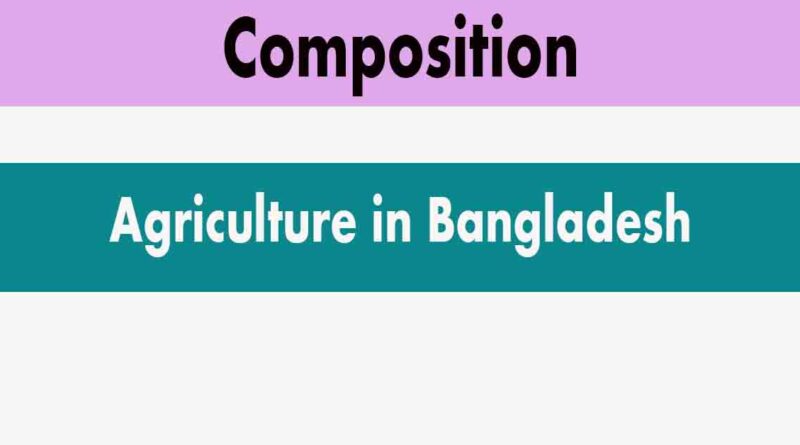Agriculture in Bangladesh composition
Introduction : Bangladesh is mainly an agricultural country. About 80% of its population makes a living from agriculture. Most of its national income comes from agriculture. It provides food for her people and raw materials for her industries. So the development of the country depends on the development of agriculture.
State of Agriculture: Bangladesh has a very rich and suitable climate for agricultural production. Our agriculture is plagued by many problems. The soil of our country is fertile but our way of farming is still very old and outdated. Farmers work their land with cows and plows.
Our farmland is fragmented into thousands of small pieces. Our farmers are illiterate, they do not know the scientific method of cultivation.
Problems of our agriculture and their solutions: Every year natural calamities like flood and drought cause great destruction in our agriculture to prevent these people and government should work together to expand irrigation facilities. The wasteland should be cultivated. Soil erosion needs to be controlled. Distribution of better seeds to farmers at low prices should be ensured. Above all, our farmers will have to be properly educated so that they can adopt scientific methods of cultivation in their agriculture.
Major agricultural products: Our way of farming is very old and outdated. Our soil is very fertile. Thus, various types of agricultural products grow here. Major products include rice, jute, sugarcane, tea, tobacco, wheat and pulses. Every year we export tea, jute and tobacco and earn millions of foreign currency.
Improvement in Agriculture: Our government is trying hard to improve our agriculture. Our farmers have already started using modern cultivation methods. Row sowing has already been introduced for rice and jute cultivation. Bangladesh Rice Research Institute (BRRI) and Bangladesh Agricultural Research Institute (BARI) are doing a lot to improve seeds and cultivation methods in the country.
Conclusion: Our national economy is based on agriculture. The development of our economy depends primarily on the development of our agriculture. Therefore, we should develop our agriculture and increase our agricultural production. The government has already taken various steps to improve the condition of our agriculture.
composition: Duties of a student composition
Agriculture in Bangladesh composition for Hsc
Introduction: Agriculture is the backbone of Bangladesh’s economy, employing a significant portion of its population and contributing significantly to the country’s GDP. The fertile land and favorable climatic conditions have made agriculture a vital sector in Bangladesh, supplying food, employment, and raw materials for various industries. This composition sheds light on the importance, challenges, and advancements in agriculture in Bangladesh.
The Significance of Agriculture:
Economic Backbone: Agriculture is a crucial driver of Bangladesh’s economy, contributing approximately 15% to the country’s GDP. It also serves as the primary source of livelihood for a large portion of the population, especially in rural areas.
Food Security: Agriculture plays a vital role in ensuring food security for Bangladesh’s growing population. The country produces a variety of crops, including rice, wheat, jute, and pulses, which are staples in the Bangladeshi diet.
Employment Opportunities: Agriculture provides employment opportunities to millions of people, both directly and indirectly. It encompasses farming, fisheries, livestock rearing, and agribusiness, offering livelihoods to a diverse range of individuals.
Challenges in Bangladeshi Agriculture:
Land Fragmentation: One of the significant challenges in Bangladeshi agriculture is land fragmentation due to population pressure. Smaller landholdings limit agricultural productivity and intensify land-use conflicts.
Climate Change Vulnerability: Bangladesh is highly susceptible to the impacts of climate change, including floods, cyclones, and sea-level rise. These events can disrupt agricultural activities, causing crop losses and damage to infrastructure.
Inadequate Infrastructure: The lack of modern infrastructure, such as irrigation systems, storage facilities, and transportation networks, hampers agricultural productivity and the ability to access markets.
Pest and Disease Management: Pests and diseases pose a continuous threat to crops and livestock. Proper pest management and disease control are essential for sustainable agriculture.
High-Yield Varieties: Bangladesh has adopted high-yield crop varieties, such as the famous “Boro” rice, which has significantly increased rice production.
Irrigation Projects: The government has invested in irrigation projects to enhance water management, particularly during the dry season, and improve crop yields.
Agricultural Diversification: Efforts are being made to diversify agricultural products beyond traditional staples. This includes promoting the cultivation of fruits, vegetables, and cash crops.
Research and Extension Services: Agricultural research institutions and extension services are working to develop and disseminate innovative farming techniques and technologies to farmers.
Export Opportunities: Bangladesh is exploring export opportunities for its agricultural products, such as frozen shrimp, ready-made garments, and pharmaceuticals.
Conclusion: Agriculture in Bangladesh plays a pivotal role in the country’s economy, food security, and employment generation. Despite facing challenges like land fragmentation and climate change vulnerability, Bangladesh has made significant strides in modernizing its agricultural practices through the adoption of high-yield varieties and improved infrastructure.
With continued investments in research, technology, and sustainable farming practices, Bangladesh can further strengthen its agricultural sector, ensuring food security, economic growth, and improved livelihoods for its population.




